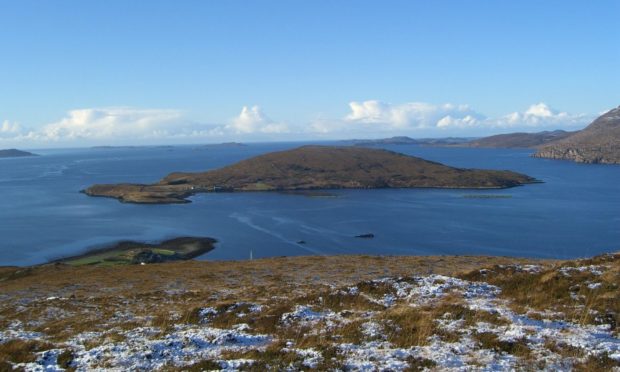A caretaker’s job is up for grabs on a unique uninhabited Scottish island with no running hot water and just enough electricity to charge a phone or a laptop.
Candidates who want to live for the summer on Isle Martin can instead enjoy natural beauty, bird watching and archaeology.
Isle Martin is situated at the mouth of Loch Broom, three miles north-west of Ullapool in Wester Ross.
It has been the site of a monastery, a herring curing station and a flour mill. Now recognised as a bird sanctuary, it is owned and managed by a community trust.
The nearest mainland is less than a mile away at Ardmair.
The 400-acre island lies below the towering cliffs of Beinn Mhor Coigach and opposite the ancient Viking Fort of Dun Canna.
Beyond the island are the Summer Isles – said to be the inspiration for The Wicker Man cult film – with the main isle of Tanera Mor being redeveloped for tourism by hedge fund tycoon Ian Wace.
The job
The Isle Martin Trust was established in May 1999 as guardian of the island on behalf of the communities of Lochbroom and Coigach after it was gifted by the RSPB.
Now it wants a “temporary resident” caretaker/housekeeper.
“Expressions of interest are invited for a voluntary post on our community-owned island from June to end September 2021,” says the advert.
“This post is open to one person or two people sharing.
“The caretaker will manage their own duties drawn up in agreement with the trustees equivalent to approximately three hours per day.
“There is scope to enjoy many opportunities the island offers such as ornithology, walking, water sports, art, archaeology, gardening, general care for the land, buildings and environment.
“We welcome volunteers who bring specific skills they may wish to share for the benefit of the community during their time on the island.”
Daily tasks could involve:
- cleaning toilets
- supervising/carrying out Covid-compliant sanitising
- meeting and greeting visitors
- assisting visiting volunteers
- cash handling.
The perks
“Basic accommodation is provided free and likely to be in the Boa House
“At least one person applying must have powerboat driving competency.
“Expenses of £150/week available. No further expenses are available for locating to the island although use of the boat is free.
“We would be happy to hear from people living within the communities of Lochbroom and Coigach. We also welcome applications from people of under-represented groups.”
To apply candidates must write a maximum of 500 words describing themselves, their relevant knowledge, experience and skills and why they should be considered for the post.
The deadline is Tuesday (June 1).
The trustees add: “We are a tiny charity run by volunteer directors and at this stage we are unable to enter into any correspondence or answer any queries about this post. That’s part of the adventure.
“If you don’t hear back from us by June 10 we’re sorry but your application will not be progressed further.”
History of the island
There is little in the way of documented history of Isle Martin prior to the late 18th century. The island must have been an important place for many years prior to that. It is probable that the island has been inhabited off and on for several thousand years.
The only specific, but anecdotal, references are to a St. Martin who is reputed to have established a monastery on the island, probably around 300-400 AD and after whom the island is named.
By the 18th century there was an important and active trade in fish from the island, and a John Woodhouse, from Liverpool, established a herring station and associated customs house. This closed in 1813 after successive years of failing catches. During this period there were probably around a hundred people living on the island.
A flourmill was operated between 1939 and 1948 on the old herring station site. Wheat was imported by ship, and flour supplied to bakeries across the north. Most of the mill workforce was brought by ferry from Ardmair on a daily basis.
The last private owner of the island ceased further sheep grazing in 1969. A small herd of Highland cattle was then maintained until 1979, when Mrs. Monica Goldsmith gifted the island to the RSPB and since then no domestic stock have grazed the island.
